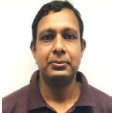
Santanu Metia
Work place: Faculty of Engineering and Information Technology, University of Technology Sydney, Sydney, NSW 2007, Australia
E-mail: Santanu.Metia@uts.edu.au
Website:
Research Interests: Signal Processing, Solid Modeling
Biography
Santanu Metia received the B.E. degree in electrical engineering from the Jalpaiguri Government Engineering College, India, in 1997, the M.S. degree in electrical engineering from the Indian Institute of Technology Kharagpur, India, in 2002, and the Ph.D. degree from the University of Technology Sydney, Australia, in 2016. He is currently a Research Associate with the University of Technology Sydney. He conducted research on mobile robotics at Swiss Federal Institute of Technology Lausanne, Switzerland. He involved in Tyristor Controlled Series Compensator project at Indian Institute of Technology, Kanpur, India. His research interests include Kalman filtering, fractional systems, indoor air quality modeling, climate change, and air quality modeling, biomedical signal processing.
Author Articles
A Statistical Approach for Investigation and Comparison of Fatigue and Drowsiness based on Complexity Parameters of EOGs
By Ashis Kumar Das Prashant Kumar Suman Halder Santanu Metia
DOI: https://doi.org/10.5815/ijigsp.2023.05.04, Pub. Date: 8 Oct. 2023
The primary factors contributing to road accidents are drowsiness and fatigue. Additionally, it diminishes productivity within work environments and elevates the likelihood of accidents. The analysis of bio-signals is crucial in the examination of various physical conditions and the physiological state of an individual. Various biological signals were utilized to identify the presence of fatigue and drowsiness that is associated with fatigue. Various physiological signals were employed to identify driver or operator fatigue and drowsiness. Out of all these non-invasive signals, electrooculogram (EOG) exhibits well-accepted outcomes for detecting drowsiness and fatigue. By employing an EOG-based study, the real-time monitoring of the muscle and mental fatigue of the human subject can be done when they are engaging in their everyday activities. The present studies sought to employ a statistical analysis of electrooculograms (EOGs) to ascertain the stress levels of participants and provide insight into their state of fatigue and drowsiness. Two different experimental studies were performed with 120 and 80 healthy male and female research scholars of National Institute of Technology Durgapur, India. EOGs were recorded by the Biopac MP 45 data acquisition system at two and three different sessions of a day with huge cognitive tasks in between. Several entropies are evaluated from the time domain and frequency domain. The others complexity parameters are also incorporated to enrich the results of the experimental processes. An inferential statistical analysis based on the parametric t-test and non-parametric Wilcoxon test for study-I was considered to compare the stress levels between morning and evening sessions. Similarly, in study-II, the parametric ANOVA test and non-parametric Friedman test were carried out to monitor stress level in three different sessions of a day. The Tukey-Kramer post-hoc test is also undertaken to compare the outcomes among three different sessions and find the statistical differences based on a 5% significance level. Most complexity parameters show excellent results and clear differences in fatigue states for both the experiments and these analyses indicates the presence of onset fatigue among the subjects under consideration.
[...] Read more.Other Articles
Subscribe to receive issue release notifications and newsletters from MECS Press journals